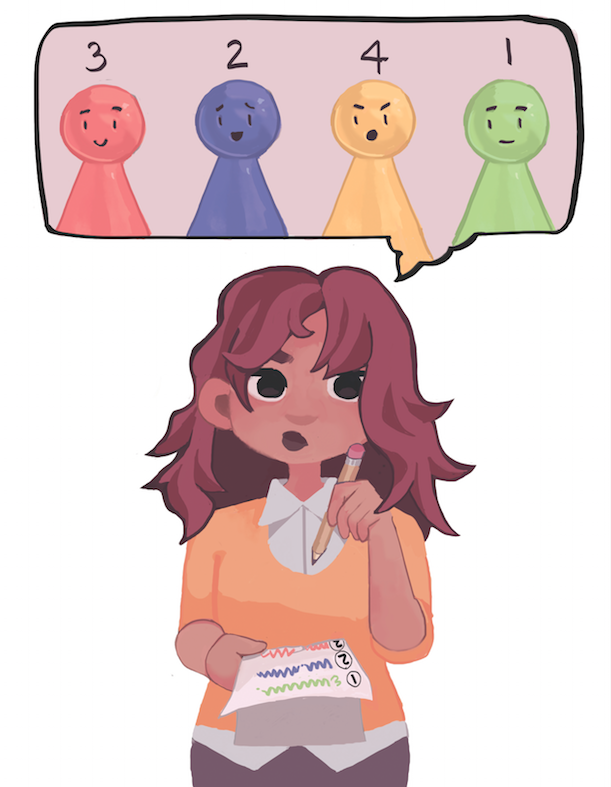Our Elections Are Stupid: How to Make Them Less Dumb
by Bryanne McDonough | published Nov. 4th, 2016
First off, screw the two-party system. Secondly, screw the electoral college. Oh, and first-past-the-post (FPTP) is dumb AF.
FPTP is a voting system in which voters select the candidate of their choice on the ballot and the candidate that gets the most votes wins, unlike past presidential elections where that wasn't necessarily true — let's not forget the 2000 election when Al Gore won the popular vote but lost the presidency. Leaving the (stupid) electoral college out of it, FPTP has many problems just by virtue of existing. But it doesn't have to be that way, my friends. It doesn't have to be terrible.
An instant-runoff voting (IRV) system would fix many problems presented here. It has the potential to change the way voters approach elections, give hope to third parties and bring out new voters. Most importantly, it could make our voices heard.
Problems With FPTP
To start with, FPTP encourages tactical voting. This current election, more than ever, highlights this problem. There are many voters who will vote not based on who they think the best president would be, but based on who they don't want to be president. Many voters feel that they must vote for the "lesser of two evils" between the Democrats and Republicans, because voting third party would effectively take votes away from the candidate they think would mess up the least. While this sentiment is essentially irrelevant unless you live in a swing state, it exists and will affect many voters' decisions.
The current system only encourages the two major parties because voters see them as the only options. Voting for other parties may feel like a waste of a vote. FPTP also encourages gerrymandering — the practice of dividing up constituencies to unfairly favor a certain party. By ensuring that there are a small number of districts with many "Blue" voters, a "Red" party can win by a small majority in a large number of districts.
Instant-Runoff Voting
Let's make America not terrible.
IRV starts with a ballot that allows you to rank candidates according to your preference. The top-ranked candidate on each ballot is then tallied up. If a candidate gets more than 50 percent of these votes, they win. However, if there is no clear majority, the candidate with the fewest votes gets removed from the election and from the rankings on each ballot. That candidate's voters then get distributed according to their second choice. The top-ranked candidates of each ballot are counted again and the process continues until one candidate is the top remaining choice.
Say there are two similar candidates, Alice and Bob, who share 60 percent of voters. Another candidate, Carl, has the other 40 percent. If Alice and Bob split their voting pool 25/35, Carl has the simple majority and would win in an FPTP system. However, in IRV, voters supporting Alice would put Bob as their second choice, and vice versa. Then, Alice would get eliminated in the second round and all of Alice's 25 percent of voters would go to support Bob and he would win.
That's just common sense. If the majority of voters would prefer either Alice or Bob to Carl, then either Alice or Bob should win. But that's not how America does things.
Minority Votes Matter
(Disclaimer: This is not about racial/ethnic/sexual/romantic/gender minorities, although their votes do matter.) A vote that goes to a losing candidate that maybe nobody even knows about should matter while not being "wasted." The point of a vote is to tell the government what you want, what you think your country/state/town should be like and what laws need to exist. If you believe a candidate is the best for the job, but a more popular candidate would be your second choice, you should be able to express that. In an FPTP system, a voter may be more inclined to vote for a more popular candidate so that an undesirable candidate doesn't win. If this happens, the less popular candidate can't show that their position is one that is still supported by some voters.
We can't tell the government what we want them to do if our votes don't represent what we want. An IRV system would allow voters to vote for what they believe while allowing the most preferred candidate to win. Every vote should matter, even if that vote chooses the least popular candidate as their top choice.
Implementing IRV
It isn't easy to implement a new system of voting. IRV is already used in several cities for mayoral and other positions. The only statewide IRV election was in North Carolina for an opening in the State Court of Appeals in 2010, but the legislation that allowed this was later repealed. If we want to vote with this system, legislatures need to be pressured to change the existing laws.
The effort will be well worth it, though. FairVote.org, an advocacy organization for IRV, conducted research that showed voter turnout increased by 10 points when ranked-choice voting was compared to traditional voting methods. Arguments against IRV will say that it may be too difficult to understand. However, research shows that 84 percent of voters understood ranked-choice voting "somewhat well" compared to 83 percent for understanding FPTP.
IRV is Just the Beginning
There are many things wrong with our current system. IRV won't eliminate gerrymandering, the electoral college, the two-party system or our business-funded politicians. It is, however, a step in the right direction. Constituents' voices could be heard better than ever before. With third-party candidates getting more voice, we can work on the two-party system and vote for candidates who decline donations from big businesses and call out what needs fixing.
It will be long and arduous, but this journey will give us a country that is under our control and a government that has to listen.



